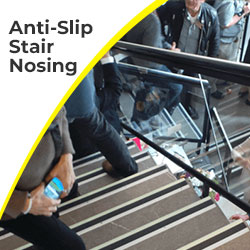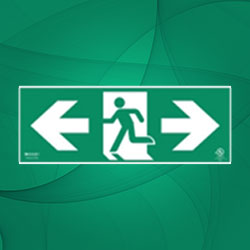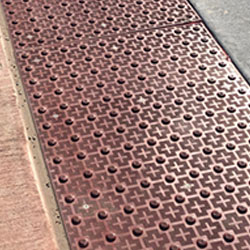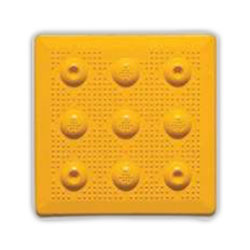























































































































When retrofitting existing structures to comply with accessibility regulations, choosing the most cost-effective tactile solutions becomes quite important. As the leading tactile products supplier in Canada, here at Tactile Solution Canada, we understand this challenge well. This blog highlights some highly affordable tactile options well-suited for upgrading structures on a tight budget.
As per the Accessibility for Ontarians with Disabilities Act (AODA) and the National Building Code of Canada (NBC), installing tactile tiles is mandatory to ensure safe navigation for pedestrians with vision impairment. While newbuilds can seamlessly integrate cast-in-place tiles, retrofits usually need " tactile, "glued" to the existent surface".
As discussed in our previous blog, " surface applied tiles" offer a pragmatic solution for upgrading tactility on "existent surfaces" like pavements and flooring. These tiles offer a convenient and affordable way to install tactile walking surface indicators on existing surfaces, unlike more expensive options, embedded concrete. These durable tiles attach securely to surfaces like sidewalks, ramps, platform edges, stair treads, or landings with special adhesives built to withstand heavy foot traffic, freeze/thaw cycles, salt, and moisture.
Compared to tearing up and re-pouring concrete, installing surface-mounted tactile pads provides tremendous cost and labor savings. Tiles offer flexibility to contour curved surfaces and radii seamlessly. They can also be precision cut onsite to fit any shape. Color choices contrast against surroundings to enhance detectability. These versatile solutions work excellently to create accessible routes through public parks, transit centers, government buildings, healthcare campuses, shopping centers, and other facilities.
We'll highlight four great surface-applied tactile products that meet Canadian standards that balance durability and ADA/AODA compliance with affordability!
AccessTile leads the industry for affordable detectable warning systems perfect for retrofit applications. Their surface-applied truncated dome tiles are installed easily to add tactile curb ramps, platform edges, and other hazards needing bright visual and textured contrast between pedestrian and vehicular routes such as curb ramps, wheelchair ramps, top of stairs/escalators, and blended transitions.
AccessTile's surface-mounted wayfinding bars are installed together with their truncated dome tiles to create full AODA-compliant accessible routes. These detectable directional bars guide users along paths between destinations like information kiosks, registration desks, and elevator banks.
Boasting excellent durability and traction, Armor-Tile surface-applied tactile pads bring enhanced accessibility anywhere without breaking budgets. The tiles made from proprietary polymers blend optimal slide resistance, sound properties, and textured profiles to improve detectability and grip for canes/walkers.
Eon Tile's flexible rubber tactile tiles suit both interior and exterior applications requiring custom sizing to unique measurements. These durable, resilient pads install perfectly along curved walkways and radii.
Installing proper TWSI tiles improves accessibility and minimizes liability risks across properties receiving public foot traffic. Tactile warning surfaces represent excellent return on investment over their long lifespans.
Ideally, begin budgeting early once consider enhancing accessibility among retail spaces, transit platforms, public parks, and government sites. This allows for appropriate funding for quality tactile installations.
Explore federal and provincial grants incentivizing accessibility upgrades under the Accessibility for Ontarians with Disabilities Act (AODA) supporting goals for barrier-free Canada by 2040.
For large-scale retrofitting, break projects into budget-friendly phases, first addressing high-priority areas to balance immediate needs against stretched capital resources.
As Canada's leading supplier of durable ADA and AODA-compliant tactile solutions, Tactile Solution Canada stands ready to assess retrofitting requirements, recommend appropriate systems balancing durability, detectability, and affordability, plus support contractors through environmentally friendly installations, improving accessibility at facilities across provinces.
Quality surface-applied tiles from AccessTile, Armor-Tile, and Eon Tile balance affordability with durability, ADA/AODA, CSA compliance, and ease of installation for retrofit applications. Their customizable modular designs allow cost-effectively tailoring detectable warnings to site parameters.
When installed adequately following manufacturer guidelines onto concrete or asphalt surfaces, most surface-applied tactile systems provide 10-15 years lifespans in outdoor conditions and 20+ years indoors before needing replacement.
Look for surface-applied tactile tiles containing polymers, composite metals, or porcelain stoneware materials resistant to corrosion, fractures, wear, and wear-and-tear. Avoid natural woods or plastic composites vulnerable to exterior conditions.
Great information sources include the Canadian Revenue Agency, Canada Mortgage and Housing Corporation, Ontario Renovates Program, and local provincial accessibility directorates. Consulting an accessibility specialist also helps navigate the best funding support.
The federal Accessible Canada Act harmonizes nationally with provincial laws like Ontario's Accessibility for Ontarians with Disabilities Act (AODA), which provides standards all public buildings must achieve. Local building codes often reference these laws.
We hope these surface-mounted tactile solution options and budgeting tips assist your team's planning process when navigating important retrofitting decisions ahead. Please get in touch with Tactile Solution Canada for personalized guidance tailoring the optimal product recommendations unique to your retrofitting project requirements and budget.
